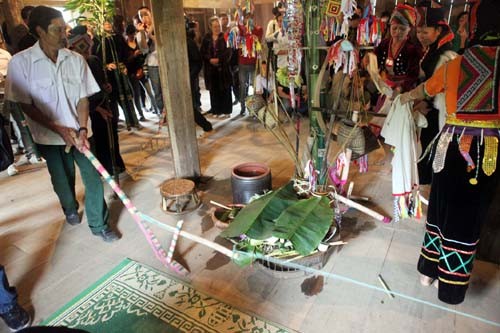(VOVWORLD) -The La Ha people live in Vietnam’s northwestern region, mainly in Lao Cai, Son La, and Lai Chau province. In the past they lived off the land in isolated remote mountains, where they developed unique customs and rituals.
 Hoa Mang festival Hoa Mang festival
|
Researchers say the La Ha settled in Vietnam’s northwest region long ago. Ancient documents of the Thai ethnic group say that when the Black Thai migrated here in the 6th and 7th century, they found the La Ha already living here. In the past, the La Ha lived apart and used primitive cultivation methods. Now they live in harmony with other ethnic groups like the Dao and the Thai.
Hoang Van Ten is a La Ha man who lives in Than Uyen district, Lai Chau province. “In the old days, the La Ha cultivated small plots near brooks. Then they imitated the Thai by growing wet rice. Their fields are close to their houses so they don’t lose time walking.”
A La Ha hamlet has about twenty households living in stilt houses. Each stilt house has one door to welcome guests and one door for the family members. Children take the family name of the father and the wife adopts her husband’s family name.
 A shaman performs the Hoa Mang worship ritual A shaman performs the Hoa Mang worship ritual
|
A mature man who wants to get married must prepare wedding presents for the bride and for her parents, to thank them for raising her. Before the wedding ceremony, the man has to live with the woman’s family for a time. Afterwards, they move in with the groom’s family and the wife takes her husband’s family name.
The La Ha don’t grow cotton to weave fabric but they are very good at making bamboo and rattan products. Ten again: “The La Ha weave various kinds of bamboo containers. They trade their bamboo products to the Thai for clothes, so they dress like the Thai.”
The La Ha have their own religious customs and festivals. The Hoa Mang festival is a big annual event to express gratitude to the genies and ask them for prosperity, happiness, and good crops. They prepare offerings for the tiger genie, the king of the forest, and the spotted dove, a bird genie who protects their fields. After the rituals, shamans perform plays demonstrating the way they cure sick people and the way field-keepers chase away birds and wild animals.
The festivals preserve traditional rituals while providing an opportunity for people to discuss work, health, and their shared experience.